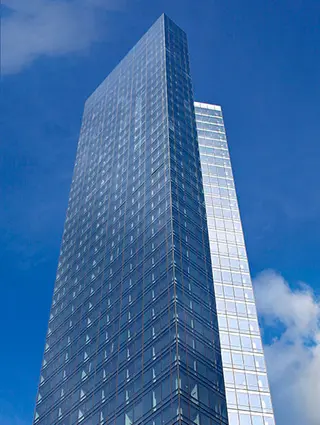 Carter Horsley
Carter HorsleySep 16, 2015
Carter's Review
The Aire is a very impressive, very slick and very handsome, 43-story, rental apartment building at 200 West 67th Street on the northwest corner at Amsterdam Avenue.
It was erected in 2010 and has 275 apartments.
It was built by A&R Kalimian Realty and designed by Handel Architects, which also designed the more recent 170 Amsterdam Avenue, an apartment building one block north with a very dramatic exoskeleton, one block south of the low-rise and wavy Lincoln Square Synagogue building, a very handsome project by Cetra/Ruddy.
This building replaced a Red Cross Building and is to the east of the mammoth Lincoln Towers complex.
Handel’s two buildings, the synagogue, and the very fine Martin Luther King Jr. High School designed by Frost Associates at 122 Amsterdam Avenue – all in a row - insert exciting architectural drama to a formerly rather pedestrian precinct to the north of the Lincoln Center for the Performing Arts.
Bottom Line
With its striking and soaring mirror-glass reflections and sharp corners, this tower adds considerable razzle-dazzle and sculptural flair to the Lincoln Center area and has a rather spectacular array of amenities.
Description
This gleaming tower has a low-rise base along Amsterdam Avenue highlighted by long horizontal windows housing community facilities.
The slab tower’s ends are sharply angled and the top several floors have balconies facing east that are very prominent and give substantial character to the top of the building.
In an April 30, 2010 article in The New York Times, C. J. Hughes wrote that “The Aire’s common areas evoke an expensive resort,” adding that “the centerpiece of a cavernous 6,000-square-foot lobby, with floors made of stone and walls lined with tamo, a Japanese wood, will be a 42-foot-long nature-themed mural.” The article quoted Steven Shokouhi, a principal at Kalimian, as stating that “the idea is to give you the feel of condo life” as “he gestured at the boxcar-sized mailroom where residents can address their envelopes and packages on a long black granite table.”
Amenities
Parking, rehearsal rooms, a children’s playroom and outdoor play space, a private party and event deck with dramatic catering pavilion in Ipe wood and Rein zinc, a library, a conference room, a fitness center, a doorman and a concierge, and a heated granite drive with up-lit waterfall, mostly with considerable sculptural flair.
Apartments
Apartment 41C is a two-bedroom unit with an entry foyer leading to a 11-foot-wide dining area with a large terrace next to an open kitchen and a 25-foot-wide, 6-sided, corner living room.
Apartment 40C is a three-bedroom unit with an 18-foot-long living/dining room with an open kitchen and a 35-by-27-foot terrace.
Apartment D on the 33rd through the 39th floors is a three-bedroom unit with an entry by the kitchen leading to a 7-foot-long dining area and a 20-foot-long corner living room.
Apartment G on the 15th through the 32nd floors is a three-bedroom unit with an entry foyer and a long hall to a 25-foot-long living/dining room with an open kitchen with an island.
Apartment F on the 4th through the 14th floors is a one-bedroom unit with an entry to an open kitchen that leads to an angled 16-foot-long living room and a 12-foot-long dining area.
Apartment G on the 4th through the 14th floor is a one-bedroom unit with an open, pass-through kitchen and a 14-foot-long living area.
Apartment D on the 15th through the 32nd floors is a studio unit with a 13-foot-long living area and a 9-foot-long sleeping alcove and a kitchen.
Apartment H on the 5th through the 14th floors is a studio unit with a 16-foot-long living area and a pass-through kitchen.
History
On his website, architect Christian de Portzamparc noted that “in 2005, the New York City Opera wanted to move to a plot of land acquired by Albert Kalimian on the site of the Red Cross, next to Lincoln Center, where they wanted to build a new opera house, offices and accommodation.”
“By proposing to construct a public, non-profit building,” he continued, “the developer was awarded additional air-rights by city hall, the right to build a tall structure. Christian de Portzamparc responded to this dual brief with a geometric collision between the apartment blocks and the opera house. Towers thrusting towards the sky from the façade of the theater accommodate the apartments forming a vertical signal, while at the level of Amsterdam Avenue the auditorium’s sphere floats in a square volume determined by the alignment of the street and protected from it by a filter of the façade and the bulb of the theater, the foyers levitate amongst the ramps and the footbridges leading to the various spaces. The arrows of the residential towers starting from the base of this filter magnify the presence of the theater at the heart of New York City.”
The most impressive phalanx of the thin apartment towers on the west side of the site flared upward with great elan above the boxy, low-rise cultural base that had very large curved window openings and rather spectacular interior massing not too clearly evident from outside.

- Rental built in 2010
- Located in Lincoln Center
- 275 total apartments 275 total apartments
- Doorman
- Pets not Allowed
 6sqft delivers the latest on real estate, architecture, and design, straight from New York City.
6sqft delivers the latest on real estate, architecture, and design, straight from New York City.
